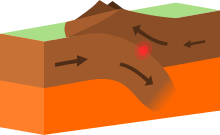
Back حدود متقاربة Arabic Cantu converxente AST Límit convergent Catalan Aktivní okraj Czech Borde convergente Spanish Muga konbergente Basque مرز همگرا Persian Convergence (géologie) French Teorainn choinbhéirseach Irish Bordo converxente Galician

A convergent boundary (also known as a destructive boundary) is an area on Earth where two or more lithospheric plates collide. One plate eventually slides beneath the other, a process known as subduction. The subduction zone can be defined by a plane where many earthquakes occur, called the Wadati–Benioff zone.[1] These collisions happen on scales of millions to tens of millions of years and can lead to volcanism, earthquakes, orogenesis, destruction of lithosphere, and deformation. Convergent boundaries occur between oceanic-oceanic lithosphere, oceanic-continental lithosphere, and continental-continental lithosphere. The geologic features related to convergent boundaries vary depending on crust types.
Plate tectonics is driven by convection cells in the mantle. Convection cells are the result of heat generated by the radioactive decay of elements in the mantle escaping to the surface and the return of cool materials from the surface to the mantle.[2] These convection cells bring hot mantle material to the surface along spreading centers creating new crust. As this new crust is pushed away from the spreading center by the formation of newer crust, it cools, thins, and becomes denser. Subduction begins when this dense crust converges with a less dense crust. The force of gravity helps drive the subducting slab into the mantle.[3] As the relatively cool subducting slab sinks deeper into the mantle, it is heated, causing hydrous minerals to break down. This releases water into the hotter asthenosphere, which leads to partial melting of the asthenosphere and volcanism. Both dehydration and partial melting occur along the 1,000 °C (1,830 °F) isotherm, generally at depths of 65 to 130 km (40 to 81 mi).[4][5]
Some lithospheric plates consist of both continental and oceanic lithosphere. In some instances, initial convergence with another plate will destroy oceanic lithosphere, leading to convergence of two continental plates. Neither continental plate will subduct. It is likely that the plate may break along the boundary of continental and oceanic crust. Seismic tomography reveals pieces of lithosphere that have broken off during convergence.
- ^ Wicander, Reed; Monroe, James S. (2016). Geol (2nd ed.). Belmont, CA: Cengage Learning. ISBN 978-1133108696. OCLC 795757302.
- ^ Tackley, Paul J. (2000-06-16). "Mantle Convection and Plate Tectonics: Toward an Integrated Physical and Chemical Theory". Science. 288 (5473): 2002–2007. Bibcode:2000Sci...288.2002T. doi:10.1126/science.288.5473.2002. ISSN 1095-9203. PMID 10856206.
- ^ Conrad, Clinton P.; Lithgow‐Bertelloni, Carolina (2004-10-01). "The temporal evolution of plate driving forces: Importance of "slab suction" versus "slab pull" during the Cenozoic". Journal of Geophysical Research: Solid Earth. 109 (B10): B10407. Bibcode:2004JGRB..10910407C. doi:10.1029/2004JB002991. hdl:2027.42/95131. ISSN 2156-2202.
- ^ Bourdon, Bernard; Turner, Simon; Dosseto, Anthony (2003-06-01). "Dehydration and partial melting in subduction zones: Constraints from U-series disequilibria". Journal of Geophysical Research: Solid Earth. 108 (B6): 2291. Bibcode:2003JGRB..108.2291B. doi:10.1029/2002JB001839. ISSN 2156-2202. Archived from the original on 2019-12-31. Retrieved 2019-09-01.
- ^ P., Kearey (2009). Global tectonics. Klepeis, Keith A., Vine, F. J. (3rd ed.). Oxford: Wiley-Blackwell. ISBN 9781405107778. OCLC 132681514.
© MMXXIII Rich X Search. We shall prevail. All rights reserved. Rich X Search